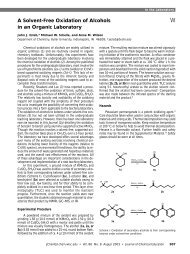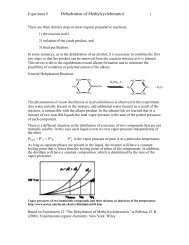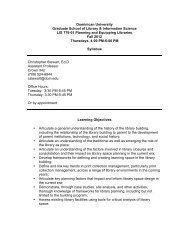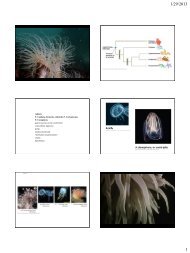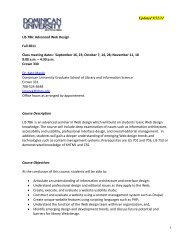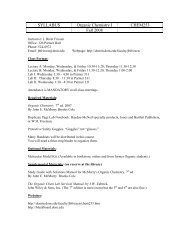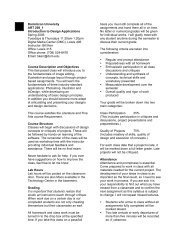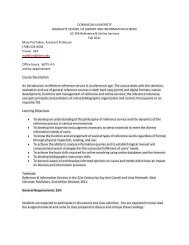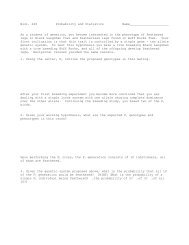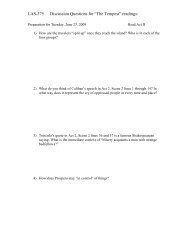Org. Chem II Experiment 9 Synthesis of Luminol - OChemOnline
Org. Chem II Experiment 9 Synthesis of Luminol - OChemOnline
Org. Chem II Experiment 9 Synthesis of Luminol - OChemOnline
You also want an ePaper? Increase the reach of your titles
YUMPU automatically turns print PDFs into web optimized ePapers that Google loves.
<strong>Org</strong>. <strong>Chem</strong> <strong>II</strong> <strong>Experiment</strong> 9 <strong>Synthesis</strong> <strong>of</strong> <strong>Luminol</strong> 3<br />
Procedure:<br />
Part I<br />
3-nitrophthalhydrazide:<br />
Place 1.3 g <strong>of</strong> 3-nitrophthalic acid and 2 mL <strong>of</strong> a 10% aqueous solution <strong>of</strong> hydrazine in a large<br />
test tube. At the same time, heat at least 20 mL <strong>of</strong> water in a beaker. Clamp the test tube to your<br />
ring stand. Heat the test tube over a microburner until the solid dissolves. Add 4 ml <strong>of</strong> triethylene<br />
glycol to the test tube. Add a boiling stone to the test tube.<br />
Monitor the heat by placing your 250° C thermometer in the test tube held in place by a split<br />
stopper and/or a clamp. The bulb <strong>of</strong> the thermometer should be immersed in the solution without<br />
touching the glass. Heat the solution with a micro burner (the small one) until the liquid boils<br />
vigorously (the temperature will rise to about 120° C). Continue heating and allow the<br />
temperature to increase rapidly until it rises above 200° C. About five minutes will be required<br />
for this heating. Remove the burner briefly when the temperature 200° C has been achieved, and<br />
then resume gentle heating in order to maintain a fairly constant temperature <strong>of</strong> 210° to 220° for<br />
about two minutes. Be careful, this tends to boil over!<br />
Allow the test tube to cool to about 100°. Add the 20 mL <strong>of</strong> hot water which was prepared<br />
previously. Cool the test tube to room temperature. Collect the crystals <strong>of</strong> 3-nitrophthalhydrazide<br />
by vacuum filtration using a Hirsch (small porcelain) funnel. Use a piece <strong>of</strong> filter paper that<br />
covers only the bottom <strong>of</strong> the Hirsch funnel. It is not necessary to dry the product thoroughly in<br />
order to proceed with the next reaction step.<br />
<strong>Luminol</strong>:<br />
Part <strong>II</strong>.<br />
Transfer the 3-nitrophthalhydrazide back to the large side-arm test tube. Add 6.5 mL <strong>of</strong> a 10%<br />
sodium hydroxide solution, and stir the mixture until the hydrazide dissolves. Add 4 g <strong>of</strong> sodium<br />
dithionite (sodium hydrosulfite). Using a pipet, add about 10 mL <strong>of</strong> water to wash the solid from<br />
the walls <strong>of</strong> the test tube. Heat the test tube with a microburner until the solution boils. Stir the<br />
solution with a long glass rod. (Do not stir with a thermometer.) Maintain the boiling, with<br />
stirring, for 5 minutes. Add 2.6 mL <strong>of</strong> glacial acetic acid.<br />
Cool the test tube to room temperature. Stir the mixture during this cooling step. Finally, cool the<br />
solution in an ice bath. Collect the crystals <strong>of</strong> luminol by vacuum filtration using a Hirsch funnel.<br />
The luminol may be used without thorough drying for the chemiluminescence experiments.<br />
Adapted from <strong>Experiment</strong> 48: <strong>Luminol</strong>, in Pavia, Lampman and Kriz, “Introduction to <strong>Org</strong>anic<br />
Laboratory Techniques: A Contemporary Approach” (1976) Saunders



